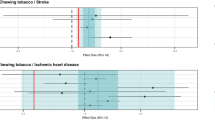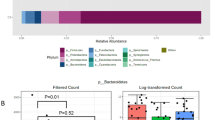Abstract
Smoking tobacco is associated with a number of gastrointestinal disorders. In some, such as Crohn's disease and peptic ulcer disease, it increases the risk of disease and has a detrimental effect on their course. In others, such as ulcerative colitis, it decreases the risk of disease and can have a favorable effect on disease course and severity. In the eighteenth and nineteenth centuries, nicotine was used as a 'panacea' for various ailments, including abdominal symptoms—it is now under investigation to elucidate its role in gastrointestinal diseases that are associated with smoking. The actions of nicotine are complex; it is likely that its effects on the central nervous system, gastrointestinal tract and immune system interact with other risk factors, such as genetic susceptibility, to influence disease outcomes. This review focuses on the mechanisms of action of nicotine that might be relevant in gastrointestinal disease.
This is a preview of subscription content, access via your institution
Access options
Subscribe to this journal
Receive 12 print issues and online access
$209.00 per year
only $17.42 per issue
Buy this article
- Purchase on Springer Link
- Instant access to full article PDF
Prices may be subject to local taxes which are calculated during checkout

Similar content being viewed by others
References
Fratiglioni L and Wang HX (2000) Smoking and Parkinson's and Alzheimer's disease: a review of the epidemiological studies. Behav Brain Res 113: 117–120
Calkins BM (1989) A meta-analysis of the role of smoking in inflammatory bowel disease. Dig Dis Sci 34: 1841–1854
Grando SA et al. (1995) A nicotinic acetylcholine receptor regulating cell adhesion and motility is expressed in human keratinocytes. J Invest Dermatol 105: 774–781
Zia S et al. (1997) Nicotine enhances expression of the α3, α4, α5 and α7 nicotinic receptors modulating calcium metabolism and regulating adhesion and motility of respiratory epithelial cells. Res Commun Mol Pathol Pharmacol 97: 243–262
Wang H et al. (2003) Nicotinic acetylcholine receptor α7 subunit is an essential regulator of inflammation. Nature 421: 384–388
Nouri-Shirazi M and Guinet E (2003) Evidence for the immunosuppressive role of nicotine on human dendritic cell function. Immunology 109: 365–373
Shytle RD et al. (2004) Cholinergic modulation of microglial activation of α7 nicotinic receptors. J Neurochem 89: 337–343
Richardson CE et al. (2001) Megacystis-microcolon-intestinal-hypoperistalsis syndrome (MMIHS) and the absence of the α3 nicotinic acetylcholine receptor subunit. Gastroenterology 121: 350–357
Richardson CE et al. (2003) Effect of smoking and transdermal nicotine on colonic nicotinic acetylcholine receptors in ulcerative colitis. Q J Med 96: 57–65
Grando SA et al. (1996) Activation of keratinocyte nicotinic cholinergic receptors stimulates calcium influx and enhances cell differentiation. J Invest Dermatol 107: 412–418
Pullan RD et al. (1994) Transdermal nicotine for active ulcerative colitis. N Engl J Med 330: 811–815
Sandborn WJ et al. (1997) Transdermal nicotine for mildly to moderately active ulcerative colitis, a randomised, double-blind, placebo-controlled trial. Ann Intern Med 126: 364–371
Sopori M (2002) Effects of cigarette smoke on the immune system. Nat Rev Immunol 2: 372–377
Geng Y et al. (1995) Effects of nicotine on the immune response I. Chronic exposure to nicotine impairs antigen receptor mediated signal transduction in lymphocytes. Toxicol Appl Pharmacol 135: 268–278
Geng Y et al. (1996) Effects of nicotine on the immune response II. Chronic nicotine treatment induces T cell anergy. J Immunol 156: 2384–2390
Kalra R et al. (2000) Effects of cigarette smoke on the immune response: chronic exposure to cigarette smoke impairs antigen-mediated signalling in T cells and depletes IP-3 sensitive calcium stores. J Pharmacol Exp Ther 293: 166–171
Matsunaga K et al. (2001) Involvement of nicotinic acetylcholine receptors in suppression of antimicrobial activity and cytokine response of alveolar macrophages to Legionella pneumophila infection by nicotine. J Immunol 167: 6518–6524
Borovikova LV et al. (2000) Vagus nerve stimulation attenuates the systemic inflammatory response to endotoxin. Nature 405: 458–462
Madretsma GS et al. (1996) Nicotine inhibits the in-vitro production of interleukin-2 and tumour necrosis factor alpha by human mononuclear cells. Immunopharmacol 35: 47–51
Van Dijk JP et al. (1995) Nicotine inhibits cytokine synthesis by mouse colonic mucosa. Eur J Pharmacol 278: 11–12
Madretsma GD et al. (1996) In-vivo effect of nicotine on cytokine production by human non-adherent mononuclear cells. Eur J Gastroenterol Hepatol 8: 1017–1020
Louvet B et al. (1999) Transdermal nicotine decreases mucosal IL-8 expression but has no effect on mucin gene expression in ulcerative colitis. Inflamm Bowel Dis 5: 174–181
Zijlstra FJ et al. (1994) Effect of nicotine on rectal mucus and mucosal eicosanoids. Gut 35: 247–251
Thomas GA et al. (1997) Effect of nicotine on large bowel mucus thickness, eicosanoids, and faecal proteinase in ferrets. Eur J Gastroenterol Hepatol 9: 179–182
Finnie IA et al. (1996) Stimulation of colonic mucin production by corticosteroids and nicotine. Clin Sci 91: 359–364
Irie K et al. (1991) L-NG-nitro-arginine inhibits nicotine induced relaxation of isolated rat duodenum. Eur J Pharmacol 202: 285–288
Green JT et al. (1999) Intra-luminal nicotine reduces smooth muscle tone activity in the distal large bowel. Eur J Gastroenterol Hepatol 11: 1299–1304
Green JT et al. (2000) Nitric oxide mediates a therapeutic effect of nicotine in ulcerative colitis. Aliment Pharmacol Ther 14: 1429–1434
Kershbaum A et al. (1968) Effect of smoking and nicotine on adrenocorticol secretion. JAMA 203: 275–278
Andersson K et al. (1983) Intravenous injections of nicotine induce very rapid and discrete reductions of hypothalamic catecholamine levels associated with increases of ACTH, vasopressin and prolactin secretion. Acta Physiol Scan 118: 35–40
Brenner T et al. (1986) Evidence that central nicotinic-acetylcholine receptors are involved in the modulation of basal and stress-induced adrenocortical responses. Exp Neurol 94: 735–743
Srivastava ED et al. (1990) Effect of ulcerative colitis and smoking on rectal blood flow. Gut 31: 1021–1024
Prytz H et al. (1989) Does smoking tighten the gut? Scand J Gastroenterol 24: 1084–1088
Loftus EV et al. (1996) Primary sclerosing cholangitis is associated with non-smoking: a case-control study. Gastroenterology 110: 1496–1502
Vleggaar FP et al. (2001) No beneficial effect of transdermal nicotine in patients with PSC: results of a randomized double-blind, placebo-controlled cross over study. Eur J Gastroenterol Hepatol 13: 171–175
Merrett MN et al. (1996) Smoking may prevent pouchitis in patients with restorative proctocolectomy for ulcerative colitis. Gut 38: 362–364
Snook JA et al. (1996) Adult coeliac disease and cigarette smoking. Gut 39: 60–62
Johnson GJ et al. (2005) Review article: smoking cessation as primary therapy to modify the course of Crohn's disease. Aliment Pharmacol Ther 21: 921–931
Russell MG et al. (1998) Inflammatory bowel disease: is there any relation between smoking status and disease presentation? European Collaborative IBD Study Group. Inflamm Bowel Dis 4: 182–186
Hugot JP et al. (2001) Association of NOD2 leucine-rich repeat variants with susceptibility to Crohn's disease. Nature 411: 599–603
Hatoum OA et al. (2003) Acquired microvascular dysfunction in inflammatory bowel disease: loss of nitric oxide-mediated vasodilatation. Gastroenterology 125: 58–69
Thomas GA et al. (1995) Is transdermal nicotine associated with cardiovascular risk? J R Coll Physicians Lond 29: 392–396
Sontag S et al. (1984) Cimetidine, cigarette smoking, and recurrence of duodenal ulcer. N Engl J Med 311: 689–693
Endoh K and Leung FW (1994) Effects of smoking and nicotine on the gastric mucosa: a review of clinical and experimental evidence. Gastroenterology 107: 864–878
Albinus M et al. (1988) The effects of nicotine on basal and stimulated gastric secretions in the conscious cat and isolated guinea pig gastric mucosal cells. Agents Actions 23: 289–292
Kowalewski K (1974) Effect of nicotine hydrogen tartrate on gastric secretion of normal and vagotomized rats stimulated with histamine, pentagastrin, and bethanechol chloride. Digestion 10: 393–401
Nakamura M et al. (2002) Cigarette smoking promotes atrophic gastritis in Helicobacter pylori-positive subjects. Dig Dis Sci 47: 675–681
Cover TL et al. (1992) Potentiation of Helicobacter pylori vacuolating toxin activity by nicotine and other weak bases. J Infect Dis 166: 1073–1078
Okayama N et al. (1995) Nicotine stimulates pepsinogen secretion from guinea pig gastric chief cells in monolayer culture. Life Sci 56: 169–177
Hunsballe JM et al. (2001) Smokeless nicotinergic stimulation of vasopressin secretion in patients with persisting nocturnal enuresis and controls. Scan J Urol 35: 117–121
Cho CH et al. (1990) The influence of acute or chronic nicotine treatment on ethanol-induced gastric mucosal damage in rats. Dig Dis Sci 35: 106–112
Shin VY et al. (2002) Nicotine suppresses gastric wound repair via inhibition of polyamine and K+ channel expression. Eur J Pharmacol 444: 115–121
Wong SH et al. (1986) The influence of chronic or acute nicotine pre-treatment on ethanol-induced gastric ulceration in the rat. J Pharm Pharmacol 38: 537–540
Lindell G et al. (1997) Acute effects of high-dose intragastric nicotine on mucosal defense mechanisms: an analysis of nicotine, prostaglandin E2, phospholipase A2, and phospholipids. Dig Dis Sci 42: 640–644
Wong D et al. (2002) Pathogenesis of nicotine treatment and its withdrawal on stress-induced gastric ulceration in rats. Eur J Pharmacol 434: 81–86
Dennish GW and Castell DO (1971) Inhibitory effect of smoking on the lower esophageal sphincter. N Engl J Med 284: 1136–1137
Waring JP et al. (1989) The immediate effects of cessation of cigarette smoking on gastroesophageal reflux. Am J Gastroenterol 84: 1076–1078
Rahal PS and Wright RA (1995) Transdermal nicotine and gastroesophageal reflux. Am J Gastroenterol 90: 919–921
Kadakia SC et al. (1996) Effects of transdermal nicotine on lower esophageal sphincter and esophageal motility. Dig Dis Sci 40: 2130–2134
Kortezova N et al. (1994) Participation of nitric oxide in the nicotine-induced relaxation of the cat lower esophageal sphincter. J Auton Nerv Syst 50: 73–78
Thomas GA et al. (1995) Transdermal nicotine as maintenance therapy for ulcerative colitis. N Engl J Med 332: 988–992
Michael JT et al. (2002) Tobacco use and cancer: an epidemiologic perspective for geneticists. Oncogene 21: 7307–7325
Li XS et al. (1996) Genotoxicity study on nicotine and nicotine-derived nitrosamine by accelerator mass spectrometry. Radiocarbon 38: 347–353
Ye YN et al. (2004) Nicotine promoted colon cancer growth via epidermal growth factor receptor, C-Src, and 5-lipoxygenase-mediated signal pathway. J Pharmacol Exp Ther 308: 66–72
Heusch WL and Maneckjee R (1998) Signalling pathways involved in nicotine regulation of apoptosis of human lung cancer cells. Carcinogenesis 19: 551–556
Heeschen C et al. (2001) Nicotine stimulates angiogenesis and promotes tumor growth and atherosclerosis. Nat Med 7: 833–839
Author information
Authors and Affiliations
Corresponding author
Ethics declarations
Competing interests
The authors have, in the past, received financial support from SLA Pharma and Kabi Pharmacia for some of their work on nicotine and inflammatory bowel disease.
Rights and permissions
About this article
Cite this article
Thomas, G., Rhodes, J. & Ingram, J. Mechanisms of Disease: nicotine—a review of its actions in the context of gastrointestinal disease. Nat Rev Gastroenterol Hepatol 2, 536–544 (2005). https://doi.org/10.1038/ncpgasthep0316
Received:
Accepted:
Issue Date:
DOI: https://doi.org/10.1038/ncpgasthep0316
This article is cited by
-
The controversial effect of smoking and nicotine in SARS-CoV-2 infection
Allergy, Asthma & Clinical Immunology (2023)
-
Long-term outcomes and risk factors for diverticulitis recurrence after a successful laparoscopic peritoneal lavage in Hinchey III peritonitis
International Journal of Colorectal Disease (2023)
-
Einfluss des Rauchens auf den Gastrointestinaltrakt
Die Radiologie (2022)
-
Epidemiology of gastroesophageal reflux disease in Iran: a systematic review and meta-analysis
BMC Gastroenterology (2020)
-
Factors Related to Upper Gastrointestinal Symptom Generation in 2275 Helicobacter pylori Seroprevalent Adults
Digestive Diseases and Sciences (2017)



